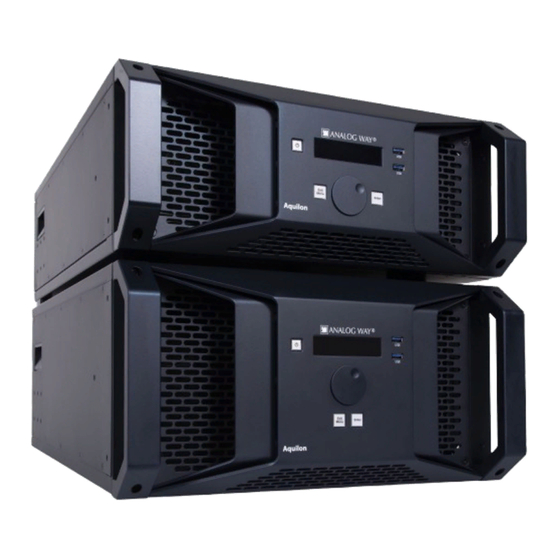
Summarization of Contents
Disclaimer and Legal Information
Copyrights and Warranty
Details on software copyrights, hardware warranty terms, and conditions for claims.
Liability and Force Majeure
Information on Analog Way's liability exclusion and force majeure circumstances.
Hardware Specifications and Safety
Safety Instructions
Essential safety guidelines for operating the LivePremier unit, including warnings and precautions.
Environmental Specifications
Details on operating temperature, humidity, and safety standards for LivePremier models.
Package Contents
List of items included in the LivePremier sales package.
Introducing the LivePremier Unit
Modular Architecture
Overview of the LivePremier's modular design and product family.
Front Panel Overview
Description of the components and functions of the LivePremier front panel.
Rear Panels
Identification of inputs and outputs on the LivePremier rear panel.
Input / Output Cards
Details on available input/output cards and how to change them.
Fixed Parts and Connections
Information on fixed components like USB, sync, Framelock, GPIO, and Dante connectors.
Power Supply Units
Details on power supply units, compatibility, and noise considerations.
Powering On and Off
Procedure for safely starting and stopping the LivePremier unit, including forced shutdown.
Mounting Precautions
Guidelines for safely mounting the LivePremier unit, ensuring proper airflow and stability.
Using the Web RCS Interface
Running the Web RCS
Requirements and steps to access the LivePremier via the Web RCS interface.
General Tips and Features
Tips for using the Web RCS, including browser features and number value adjustments.
Dashboard - System Settings
Configuration of device status, firmware, network, cooling, power, and security settings.
Save and Load Configuration
Methods for saving, loading, exporting, and importing device configurations.
Reset Configuration
Procedures for resetting the LivePremier unit configuration to default or factory settings.
LivePremier Concepts
Understanding Capacity
Explanation of capacity as bandwidth allocation and its use in formats and elements.
Screen Layers
Details on screen layers, including sources, mixing, and split layer modes.
Auxiliary Screens and Layers
Information on Aux Screens, their layer quantity, capacity, and limitations.
LivePremier Processing
Explanation of VPUs, scaling engines, and processing concepts like self-rearrangement.
HDR Conversion and Latency
Details on managing HDR profiles, conversions, and the unit's low latency performance.
Preconfiguration Menu
System Settings
Configuration of vertical rate, framelock, color space, and HDCP.
Multiviewer Quantity
Setting the number of Multiviewer outputs and their resolution.
Screens and Aux Screens Configuration
Setting output groups, rotation, format, layer modes, and assigning outputs to screens.
Canvas Settings
Defining pixel space and output settings for screens using Grid or Free types.
Input Configuration
Grouping inputs, setting formats, aspect ratios, and keying parameters.
Image Slot Configuration
Managing image slots, capacity, and assigning images or timers.
Background Configuration
Creating and managing background sets for screens.
Outputs Configuration
Outputs Main Screen
Overview of all outputs, displaying resolution, capacity, and status.
Output Settings
Detailed settings for each output, including group format, pattern, and signal.
Output Adjustment
Image correction settings for outputs, including colorimetry and luminance.
Inputs Configuration
Inputs Main Screen
Display of all inputs, showing resolution, signal type, and usage status.
Input Settings
Configuration of input signal, pattern, adjustment, aspect ratio, and keying.
Image Management
Library Operations
Managing images, including transfer, download, deletion, and formats.
Image Slots
Configuring image slots, downscaling, and assigning images or timers.
Image Aspect Ratio and Crop
Adjusting aspect ratio and cropping for image slots.
Formats and EDID Management
Custom Formats
Creating, editing, and deleting custom video formats.
EDID Management
Working with EDID bank, saving, replacing, and setting custom formats for EDIDs.
Audio and Extras
Audio Routing
Managing audio routing with and without Dante, including default and advanced modes.
Timers
Creating and controlling timers for display on screens and multiviewers.
GPIO Control
Using GPIO pins for external device control and feedback.
Screen and Aux Screen Operations
Screens Menu Interface
Navigating the Screens menu, including Program/Preview, Views, and filters.
Layer Properties
Detailed settings for layers, including position, size, transitions, opacity, and effects.
Layer Transitions
Configuring opening, closing, timing, and speed for layer transitions.
Auxiliary Screens Limitations
Specific limitations for Auxiliary Screens, such as seamless transitions and alpha channels.
Memory Management
Memories Tab
Overview of the Memories tab for saving and loading settings.
Master Memories
Saving, loading, and editing Master memories for multiple screen configurations.
Screen Memories
Saving, loading, and editing individual Screen memories.
Layer Memories
Saving, loading, and editing Layer memories for specific layer settings.
Memory Management Utilities
Renaming, changing colors, reordering, and deleting memories.
Multiviewers Configuration
Multiviewer Menu Interface
Navigating the Multiviewers menu, sources, and widget controls.
Widget Selection and Layout
Setting preview modes, selecting widgets, and using the layout editor.
Widget Properties
Configuring widget view, source, position, and size.
Multiviewer Memories
Saving, loading, and managing Multiviewer configurations.
User Maintenance and Troubleshooting
Air Filter Maintenance
Procedure for cleaning the air filter for optimal performance.
Troubleshooting Web Browser Access
Steps to resolve issues when the web browser cannot access the Web RCS.
Appendices
RC400T Controller Overview
Description of the RC400T event controller, its installation, and components.
LivePremier Control with RC400T
Instructions for controlling LivePremier units using the RC400T, including modes and assignments.
Other Control Options
Compatibility with Shot Box², Control Box², and Stream Deck for LivePremier control.





Need help?
Do you have a question about the AQL-C and is the answer not in the manual?
Questions and answers